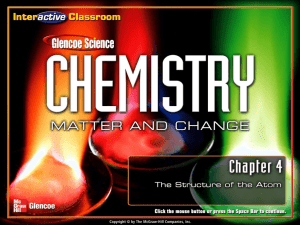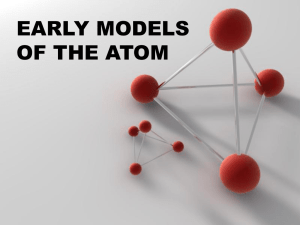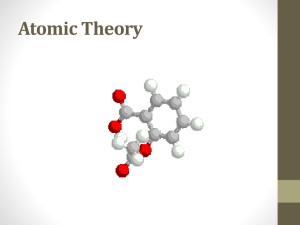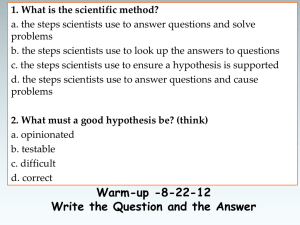Notes 4.1 and 4.2
advertisement
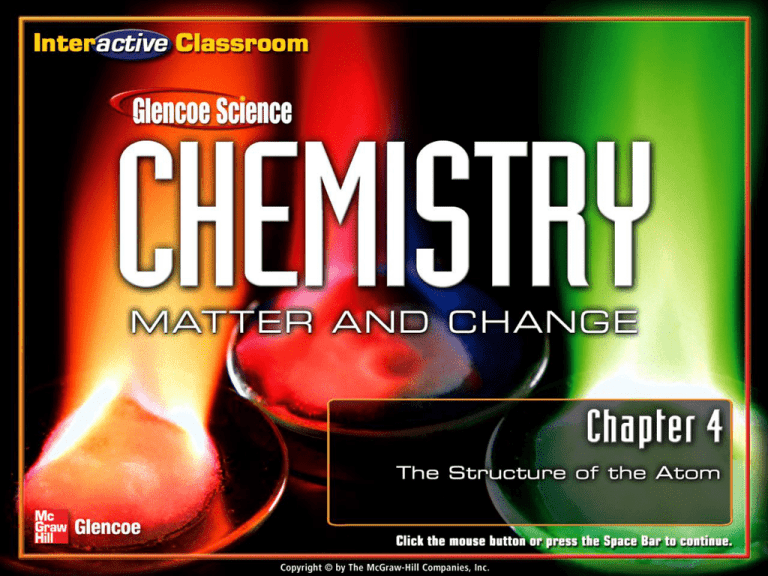
The Structure of the Atom Section 4.1 Early Ideas About Matter Section 4.2 Defining the Atom Section 4.3 How Atoms Differ Section 4.4 Unstable Nuclei and Radioactive Decay Click a hyperlink or folder tab to view the corresponding slides. Exit Section 4.1 Early Ideas About Matter • Compare and contrast the atomic models of Democritus, Aristotle, and Dalton. • Understand how Dalton's theory explains the conservation of mass. theory: an explanation supported by many experiments; is still subject to new experimental data, can be modified, and is considered successful if it can be used to make predictions that are true Section 4.1 Early Ideas About Matter (cont.) Dalton's atomic theory The ancient Greeks tried to explain matter, but the scientific study of the atom began with John Dalton in the early 1800's. Greek Philosophers (cont.) • Many ancient scholars believed matter was composed of such things as earth, water, air, and fire. • Many believed matter could be endlessly divided into smaller and smaller pieces. Greek Philosophers (cont.) • Democritus (460–370 B.C.) was the first person to propose the idea that matter was not infinitely divisible, but made up of individual particles called atomos. • Aristotle (384–322 B.C.) disagreed with Democritus because he did not believe empty space could exist. • Aristotle’s views went unchallenged for 2,000 years until science developed methods to test the validity of his ideas. Greek Philosophers (cont.) Greek Philosophers (cont.) • John Dalton revived the idea of the atom in the early 1800s based on numerous chemical reactions. • Dalton’s atomic theory easily explained conservation of mass in a reaction as the result of the combination, separation, or rearrangement of atoms. Dalton -1803 Billard Ball Model of Atom • Atoms are small, round, solid spheres Atomic Theory • All matter is made of small particles called atoms • Atoms are indivisible and indestructible • All atoms of a given element are identical • Atoms of different elements are different • Different atoms combine in whole number ratios to form compounds • Chemical reactions involve the rearrangement of atoms – no atoms are created or destroyed Greek Philosophers (cont.) Section 4.1 Assessment Who was the first person to propose the idea that matter was not infinitely divisible? A. Aristotle A 0% D D. Democritus C C. Dalton A. A B. B C. C 0% 0% 0% D. D B B. Plato Section 4.1 Assessment Dalton’s theory also conveniently explained what? A. the electron B. the nucleus D A 0% C D. law of Democritus A. A B. B C. C 0% 0% 0% D. D B C. law of conservation of mass Section 4.2 Defining the Atom • Define atom. • Distinguish between the subatomic particles in terms of relative charge and mass. • Describe the structure of the atom, including the locations of the subatomic particles. model: a visual, verbal, and/or mathematical explanation of data collected from many experiments Section 4.2 Defining the Atom (cont.) atom cathode ray electron nucleus proton neutron An atom is made of a nucleus containing protons and neutrons; electrons move around the nucleus. The Atom • The smallest particle of an element that retains the properties of the element is called an atom. • To give you an idea of how small an atom is we can look at a model. If we use an orange to represent the size of an atom, on the same scale, the orange would be the size of the Earth. • An instrument called the scanning tunneling microscope (STM) allows individual atoms to be seen The Electron • When an electric charge is applied, a ray of radiation travels from the cathode to the anode, called a cathode ray. • Cathode rays are a stream of particles carrying a negative charge. • The particles carrying a negative charge are known as electrons. The Electron (cont.) • This figure shows a typical cathode ray tube. The Electron (cont.) • J.J. Thomson measured the effects of both magnetic and electric fields on the cathode ray to determine the charge-to-mass ratio of a charged particle, then compared it to known values. • The mass of the charged particle was much less than a hydrogen atom, then the lightest known atom. • Thomson received the Nobel Prize in 1906 for identifying the first subatomic particle—the electron. This proved that Dalton was incorrect…atoms were not the smallest particles. The Electron (cont.) • In the early 1910s, Robert Millikan used the oildrop apparatus shown below to determine the charge of an electron. The Electron (cont.) • Charges change in discrete amounts— 1.602 10–19 coulombs, the charge of one electron (now equated to a single unit, 1– ). • With the electron’s charge and charge-tomass ratio known, Millikan calculated the mass of a single electron. the mass of a hydrogen atom The Electron (cont.) • Matter is neutral, it has no electric charge. • J.J. Thomson's plum pudding model of the atom states that the atom is a uniform, positively charged sphere containing electrons. The Nucleus • In 1911, Ernest Rutherford studied how positively charged alpha particles interacted with solid matter. • By aiming the particles at a thin sheet of gold foil, Rutherford expected the paths of the alpha particles to be only slightly altered by a collision with an electron. The Nucleus (cont.) • Although most of the alpha particles went through the gold foil, a few of them bounced back, some at large angles. The Nucleus (cont.) • Rutherford concluded that atoms are mostly empty space. • Almost all of the atom's positive charge and almost all of its mass is contained in a dense region in the center of the atom called the nucleus. • Electrons are held within the atom by their attraction to the positively charged nucleus. The Nucleus (cont.) • The repulsive force between the positively charged nucleus and positive alpha particles caused the deflections. The Nucleus (cont.) • Rutherford refined the model to include positively charged particles in the nucleus called protons. • James Chadwick received the Nobel Prize in 1935 for discovering the existence of neutrons, neutral particles in the nucleus which accounts for the remainder of an atom’s mass. The Nucleus (cont.) • All atoms are made of three fundamental subatomic particles: the electron, the proton, and the neutron. • Atoms are spherically shaped. • Atoms are mostly empty space, and electrons travel around the nucleus held by an attraction to the positively charged nucleus. The Nucleus (cont.) • Scientists have determined that protons and neutrons are composed of subatomic particles called quarks. The Nucleus (cont.) • Chemical behavior can be explained by considering only an atom's electrons. Section 4.2 Assessment Atoms are mostly ____. A. positive B. negative C. solid spheres D C A 0% B D. empty space A. A B. B C. C 0% 0% 0% D. D Section 4.2 Assessment What are the two fundamental subatomic particles found in the nucleus? A. proton and electron B. proton and neutron D A 0% C D. neutron and positron A. A B. B C. C 0% 0% 0% D. D B C. neutron and electron


